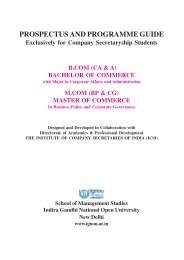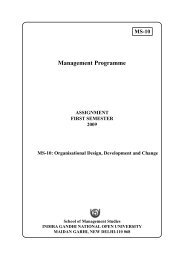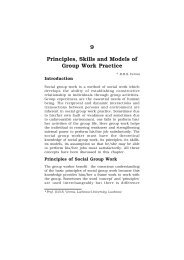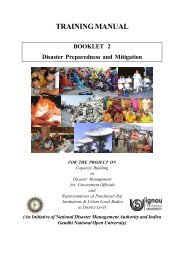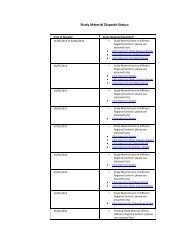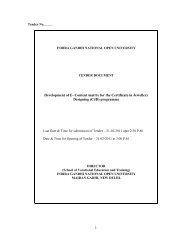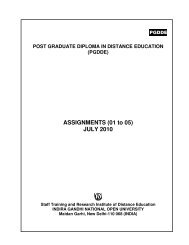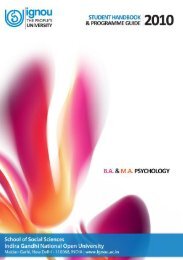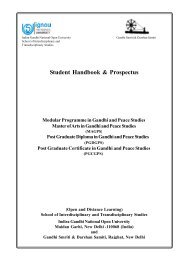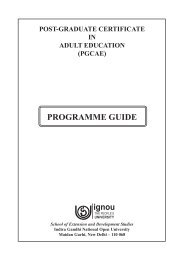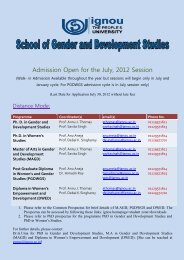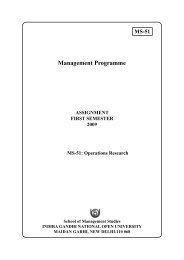Disaster Recovery and the Road Ahead - IGNOU
Disaster Recovery and the Road Ahead - IGNOU
Disaster Recovery and the Road Ahead - IGNOU
Create successful ePaper yourself
Turn your PDF publications into a flip-book with our unique Google optimized e-Paper software.
SECTION II<br />
THE ROAD AHEAD<br />
Þfodkl ,slk gks tks vkQr ls cpk,]<br />
fodkl ,slk u gks tks vkQr cu tk,AÞ<br />
“ Vikas Aisa Ho Jo Aafat Se Bachhaye, Vikas Aisa Na Ho Jo Aafat Ban Jaaye”<br />
(HPC, 2001)<br />
While disasters are calamitous events, lessons learnt <strong>and</strong> incorporated into long-term development<br />
planning may serve to minimize future vulnerability. It is certainly possible to prepare for disasters,<br />
even if <strong>the</strong>y cannot be prevented altoge<strong>the</strong>r. <strong>Disaster</strong>s are also our little windows of development.<br />
Ample opportunities for growth <strong>and</strong> prosperity are thrown open in <strong>the</strong> aftermath of disasters. If <strong>the</strong>se<br />
are lapped up, disasters can be converted into development processes. However, ironical it may<br />
sound, it is true that <strong>the</strong> destruction of unsafe infrastructure <strong>and</strong> buildings can provide an opportunity<br />
for rebuilding with better st<strong>and</strong>ards, or even relocation from a vulnerable site to a less vulnerable<br />
one.<br />
<strong>Disaster</strong>s also focus on relief aid <strong>and</strong> rehabilitation investment; <strong>the</strong>reby providing developmental<br />
opportunities that have been previously unavailable. There is, thus, a significant relationship in <strong>the</strong><br />
way disasters <strong>and</strong> development affect one ano<strong>the</strong>r. In <strong>the</strong> present scenario, disasters can no longer<br />
be viewed as r<strong>and</strong>om occurrences caused by nature’s wrath. The relationship between disaster<br />
management <strong>and</strong> environmental protection thus needs to be examined against <strong>the</strong> backdrop of <strong>the</strong><br />
disaster-development matrix, which falls under <strong>the</strong> Linking Relief <strong>and</strong> Rehabilitation with Development<br />
(LRRD), as well as <strong>the</strong> Sustainable Development (SD) Frameworks.<br />
2.1 MAINSTREAMING DISASTER MANAGEMENT<br />
An important factor to note is <strong>the</strong> increasing smudging of boundaries between natural <strong>and</strong> man-made<br />
disasters. The frequency <strong>and</strong> intensity of disasters has recorded an all-time high, as <strong>the</strong> harmonious<br />
balance between human beings <strong>and</strong> nature is being disturbed to almost irreparable proportions. If<br />
<strong>the</strong> disasters such as earthquakes, cyclones occur due to natural causes; <strong>the</strong>ir intensity is aggravated<br />
due to human factors, such as environmental destruction. So, no disaster can be categorically labeled<br />
natural anymore. Anthropogenic factors have begun to play an important role.<br />
The ‘connect’ between population growth, poverty <strong>and</strong> development is strong <strong>and</strong> complex. When<br />
assessed in terms of growth of <strong>the</strong> Gross Domestic Product (GDP), India is ahead in economic<br />
growth, yet far behind. Food insecurity, lack of means of livelihood <strong>and</strong> insufficient capacity to<br />
access resources characterize <strong>the</strong> lives of <strong>the</strong> poor even in non-disaster situations. Conditions of<br />
poverty often contribute to greater vulnerability of some sections of population to a disaster. In this<br />
context, development cannot merely be an increase in economic growth. It should focus on effective<br />
disaster management plan, which is sustainable <strong>and</strong> gives credence to creation of sustainable livelihood<br />
51



